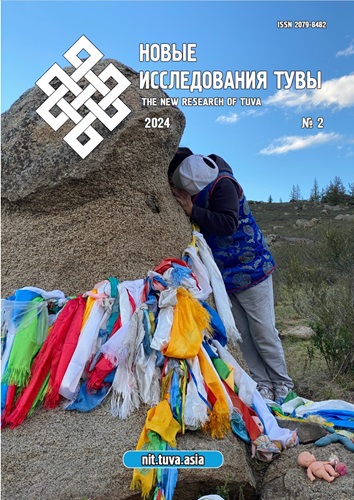Imagery in Tuvan and Belarusian proverbs (in search of common and specific proverbial images)
DOI:
https://doi.org/10.25178/nit.2024.2.2Abstract
The article examines the common and specific features of the figurative semantics of proverbs in the Tuvan and Belarusian languages, with a focus on identifying universal and unique aspects of proverbial imagery. Publications of proverbs from both languages serve as the basis for the research. It has been established that proverbial imagery is based on, firstly, semantic ambiguity and, secondly, expressiveness and figurativeness. The most significant images in proverbs from both languages are social (the world of individuals and society in their interaction), somatic (human physical nature), objective (things created by human labor), natural (inanimate nature), and faunal (living beings and their communities).
At the same time, the distribution of images in proverbs does not coincide in terms of their ranking or composition between the two languages. In Tuvan proverbs, social, faunal, somatic, objective, and natural images are more prevalent, while phytonymic images are less common. In Belarusian proverbs, the order is social, faunal, objective, natural, somatic and phytonymic. The composition of proverb images in each group is unique to different languages. However, the differences between them are most evident in quantitative terms. There are only a few proverb images that have a universal quality. These images represent the general characteristics of reality in the ethnic worldview of the Tuvan and Belarusian people.
The distribution of images in proverbs in the two languages reflects the specific way each ethnic group categorizes reality.
References
Baizhanova, N. R. (2004) Metaphorical images characterizing a person in Altai proverbs (in comparison with Tuvan ones). In: Languages of the indigenous peoples of Siberia. Ed. by N. B. Koshkareva, N. N. Shirobokova and A. R. Tazranova. Novosibirsk, NGU Publ. 236 p. Pp. 60–72. (In Russ.).
Bolat-ool, R. V. and Pelevina, N. N. (2017) The formation of the image of a woman in Tuvan and German proverbs. Vestnik Khakasskogo gosudarstvennogo universiteta im. N. F. Katanova, no. 21, pp. 29–32. (In Russ.).
Bredis, M. A. and Ivanov, E. E. (2021) Typology of proverbs of the Baltic-Finnish peoples of Russia about wealth and poverty (on the European paremiological material). Bulletin of Ugric Studies, vol. 11, no. 4, pp. 607–615. (In Russ.). DOI: https://doi.org/10.30624/2220-4156-2021-11-4-607-615
Bredis, M. A. and Ivanov, E. E. (2021) Linguoculturological commentary in polylingual dictionaries of proverbs. Russian Journal of Lexicography, 26, pp. 5–29. (In Russ.). DOI: https://doi.org/10.17223/22274200/26/1
Bytotova, R. S. (2020) Man and his characteristics in Russian and Tuvan proverbs and sayings as a reflection of national value orientations in the linguistic picture of the world. Vestnik Tuvinskogo gosudarstvennogo universiteta. Seriia 1: Sotsial'nye i gumanitarnye nauki, no. 3 (64), pp. 22–33. (In Russ.).
Varlamova, I. Yu., Budil'tseva, M. B., Pugachev, I. A. and Kuular, E. M. (2023) The image of a woman in the linguistic picture of the world of Tuvans and Russians (based on the material of phraseology in paroemias). New Research of Tuva, no. 4, pp. 44–60. (In Russ.). DOI: https://doi.org/10.25178/nit.2023.4.3
Egorova, A. I., Kondakova, A. P. and Kuzhuget, M. A. (2020) Gendernye stereotipy v tuvinskikh poslovitsakh i pogovorkakh. New Research of Tuva, no. 1, pp. 18–31. (In Russ.). DOI: https://doi.org/10.25178/nit.2020.1.2
Zinovieva, E. I. and Alyoshin, A. S. (2023) Tuvan paroemias of comparative semantics with the component сөс as compared to foreign language material. New Research of Tuva, no. 3, pp. 21–35. (In Russ.). DOI: https://doi.org/10.25178/nit.2023.3.2
Ivanishcheva, O. N. and Mentsze, Lian (2021) The World of Animals through the Prism of Folk Wisdom: a Comparative Analysis of Russian, Chinese, Tuvan and Sami Proverbs and Sayings about a Horse/Deer. Chelovek. Kul'tura. Obrazovanie, no. 3(41), pp. 106–123. (In Russ.).
Ivanov, E. E. (2019a) Aspects of empirical understanding of aphorism. RUDN Journal of Language Studies, Semiotics and Semantics, vol. 10, no. 2, pp. 381–401. (In Russ.). DOI: https://doi.org/10.22363/2313-2299-2019-10-2-381-401
Ivanov, E. E. (2019b) Aphoristic units recurrence in modern Russian language. Russian Language Studies, vol. 17, no. 2, pp. 157–170. (In Russ.). DOI: https://doi.org/10.22363/2618-8163-2019-17-2-157-170
Ivanov, E. E. (2020) Aphorism as an Object of Linguistics: the Main Properties. RUDN Journal of Language Studies, Semiotics and Semantics, no. 11 (4), pp. 659–706. (In Russ.). DOI: https://doi.org/10.22363/2313-2299-2020-11-4-659-706
Ivanov, E. E. (2022a) Semantic typology of Tuvan proverbs (empirical and axiological aspects). New Research of Tuva, no. 4, pp. 317–337. (In Russ.). DOI: https://doi.org/10.25178/nit.2022.4.22
Ivanov, E. E. (2022b) Absurd and Paradoxical Proverbs in Tuvan: Ontological and Logical Aspects of the Categorization of Proverbial Semantics. Oriental Studies, vol. 15, no. 6, pp. 1373–1389. (In Russ.). DOI: https://doi.org/10.22162/2619-0990-2022-64-6-1373-1388
Ivanov, E. E. (2022c) Aphorism in the Circle of Small Text Forms in Oral, Written and Electronic Discourses. RUDN Journal of Language Studies, Semiotics and Semantics, vol. 13, no. 4, pp. 898–924. (In Russ.). DOI: https://doi.org/10.22363/2313-2299-2022-13-4-898-924
Ivanov, E. E. (2022d) Functions of aphoristic units in the Russian language. Russian Language Studies, vol. 20, no. 2, pp. 167–185. (In Russ.). DOI: https://doi.org/10.22363/2618-8163-2022-20-2-167-185
Ivanov, E. E. (2023a) Linguoculturological commentary in the Tuvan-Russian-English Paremiological Dictionary. New Research of Tuva, no. 1, pp. 243–258. (In Russ.). DOI: https://doi.org/10.25178/nit.2023.1.14
Ivanov, E. E. (2023b) Categorization of Attitude to Reality in Paremiological Units. RUDN Journal of Language Studies, Semiotics and Semantics, vol. 14, no. 4, pp. 1154–1177. (In Russ.). DOI: https://doi.org/10.22363/2313-2299-2023-14-4-1154-1177
Ivanov, E. E., Lomakina, O. V. and Neliubova, N. Yu. (2021) Semantic analysis of Tuvan proverbs: models, imagery, concepts (against the European paremiological background). New Research of Tuva, no. 3, pp. 220–233. (In Russ.). DOI: https://doi.org/10.25178/nit.2021.3.17
Ivanov, E. E., Lomakina, O. V. and Petrushevskaia, Yu. A. (2021) The National Specificity of the Proverbial Fund: Basic Concepts and Procedure for Determining. RUDN Journal of Language Studies, Semiotics and Semantics, vol. 12, no. 4, pp. 993–1032. (In Russ.). DOI: https://doi.org/10.22363/2313-2299-2021-12-4-996-1035
Ivanov, E. E., Marfina, Zh. V. and Shkuran, O. V. (2022) Animal nouns in Tuvan proverbs and sayings: problems of studying and aspects of functioning. New Research of Tuva, no. 1, pp. 47–68. (In Russ.). DOI: https://doi.org/10.25178/nit.2022.1.4
Ivanov, E. E. (2000) Semantics of Belarusian aphorisms. Vestsі Gomel'skaga dziarzhaunaga unіversіteta, no. 2, pp. 94–99. (In Belarussian).
Ivanov, E. E. (2017) Aphoristic units in the Belarusian language. Magіleu, MDU іmia A. A. Kuliashova. 208 s. (In Belarussian).
Ivanov, E. E. and Petrushevskaia, Yu. A. (2021) The main components of a proverb as a linguistic unit: a proverbial structural and semantic model. Vestsі BDPU. Seryia 1: Pedagogіka. Psіkhalogіia. Fіlalogіia, no. 4, pp. 44–52. (In Belarussian).
Ivanov, E. E. and Petrushevskaia, Yu. A. (2022) The main components of a proverb as a linguistic unit are: lexical composition, grammatical organization, formal and structural-semantic variants. Vestsі BDPU. Seryia 1: Pedagogіka. Psіkhalogіia. Fіlalogіia, no. 1, pp. 75–79. (In Belarussian).
Kolesnikova, S. M. (2022) Gradable semantics in Russian and Tuvan proverbs. New Research of Tuva, no. 1, pp. 90–103. (In Russ.). DOI: https://doi.org/10.25178/nit.2022.1.6
Kuzhuget, Sh. Yu., Suvandii, N. D., Dambaa, Sh. V. and Lamazhaa, Ch. K. (2019) The concept of torel ('relative') in the Tuvan linguistic world picture. New Research of Tuva, no. 3, pp. 149–157. (In Russ.). DOI: https://doi.org/10.25178/nit.2019.3.12
Kurbatskii, G. N. (2001) Tuvans in their folklore (historical and ethnographic aspects of Tuvan folklore). Kyzyl, Tuvinskoe knizhnoe izdatel'stvo. 464 p. (In Russ.).
Lepeshau, І. Ia. (2006) Paremiology as a separate branch of linguistics. Grodna, GrDU іmia Iankі Kupaly. 279 p. (In Belarussian).
Lomakina, O. V. (2022) Tuvan paremiology: its linguoculturological and linguoaxiological potential. New Research of Tuva, no. 1, pp. 6–16. (In Russ.). DOI: https://doi.org/10.25178/nit.2022.1.1
Lopsan, A. P. (2022) Gender stereotypes in proverbs and sayings of the Tuvan language. Vestnik Tuvinskogo gosudarstvennogo universiteta. Seriia 1: Sotsial'nye i gumanitarnye nauki, no. 4 (100), pp. 44–53. (In Russ.).
Marfina, Zh. V. and Shkuran, O. V. (2022) The theme of kinship in Russian and Tuvan parodies as a reflection of traditional family values. Vestnik Tverskogo gosudarstvennogo universiteta. Seriia: Filologiia, no. 3 (74), pp. 136–153. (In Russ.).
Mongush, Sh. V. (2023) The role of proverbs in the representation of the concept hunting in Tuva linguacultural. Kognitivnye issledovaniia iazyka, no. 3–1 (54), pp. 758–762. (In Russ.).
Neliubova, N. Yu. (2022a) Axiological dominants of paremies as typological markers in Russian, Tuvan and French ethnic cultures. New Research of Tuva, no. 1, pp. 146–163. (In Russ.). DOI: https://doi.org/10.25178/nit.2022.1.10
Neliubova, N. Yu. (2022b) The axiological function of animalistic images in French and Tuvan proverbs. Vestnik Cheliabinskogo gosudarstvennogo universiteta, no. 9 (467), pp. 169–177. (In Russ.).
Neliubova, N. Yu. (2023) Metaphorical representation of the gastronomic cultural code in French, Russian and Tuvan parodies: axiological aspect. Kognitivnye issledovaniia iazyka, no. 2 (53), pp. 458–465. (In Russ.).
Nikolaeva, E. K., Seliverstova, E. I., Lomakina, O. V. and Suvandii, N. D. (2023) The image of a mountain in Tuvan paroemias as a manifestation of ethno-marked mentality (as compared to Altai, Khakas, Buryat and Kalmyk proverbs). New Research of Tuva, no. 3, pp. 51–64. (In Russ.). DOI: https://doi.org/10.25178/nit.2023.3.4
Paremiology without Borders (2020) / ed. by M. A. Bredis and O. V. Lomakina. Moscow, RUDN University Publ. 244 p. (In Russ.).
Paremiology in Discourse (2015) / ed. by O. V. Lomakina. Moscow, URSS; Lenand. 294 p. (In Russ.).
Paremiology at the crossroads of Languages and Cultures (2021) / ed. by E. E. Ivanov and O. V. Lomakina. Moscow, RUDN University Publ. 246 p. (In Russ.).
Petrushevskaia, Yu. A. (2022a) Belarusian parallels of Vepsian proverbs: in search of typologically common and ethno-specific. Bulletin of Ugric Studies, vol. 12, no. 3, pp. 497–505. (In Russ.). DOI: https://doi.org/10.30624/2220-4156-2022-12-3-497-505
Petrushevskaia, Yu. A. (2022b) Tuvinskie i belorusskie poslovichnye paralleli (tipologicheskaia obshchnost' na fone etnokul'turnoi spetsifichnosti). New Research of Tuva, no. 3, рр. 241–263. (In Russ.). DOI: https://doi.org/10.25178/nit.2022.3.16
Petrushevskaia, Iu. A. (2023) Tuvan and Belarusian proverbial parallels (typological community amid ethnocultural specificity). New Research of Tuva, no. 1, pp. 259–279. (In Russ.). DOI: https://doi.org/10.25178/nit.2023.1.15
Petrushevskaia, Yu. A. (2024) Chuvash parallels of Belarusian proverbs (analogous units and identical proverbial models). New Research of Tuva, no. 1, pp. 230–246. (In Russ.). DOI: https://doi.org/10.25178/nit.2024.1.15
Petrushevskaia, Yu. A. (2021) Linguistic specificity and national peculiarity of the proverbs of the Belarusian language. Magіleu, MDU іmia A. A. Kuliashova. 220 p. (In Belarussian).
Seliverstova, E. I. (2022) Binary structures in Tuvan proverbs as a manifestation of the nationally marked vision of the world. New Research of Tuva, no. 1, pp. 115–130. (In Russ.). DOI: https://doi.org/10.25178/nit.2022.1.8
Suvandii, N. D. (2023) Cher ‘earth’ in Tuvan paroemias. New Research of Tuva, no. 1, pp. 26–37. (In Russ.). DOI: https://doi.org/10.25178/nit.2023.1.2
Iankouskі, M. A. (1971) The poetics of Belarusian proverbs. Mіnsk, Vysheishaia shkola. 159 p. (In Belarussian).
Seliverstova, E. I. (2020) Levels of Manifestation of Typological Similarity in Proverbs of Different Languages. RUDN Journal of Language Studies, Semiotics and Semantics, vol. 11, no. 2, pp. 198–212. DOI: https://doi.org/10.22363/2313-2299-2020-11-2-198-212
Published
How to Cite
For citation:
Petrushevskaya Yu. A. and Lazareva O. V. Imagery in Tuvan and Belarusian proverbs (in search of common and specific proverbial images). New Research of Tuva, 2024, no. 2, pp. 24-39 (In Russ.). DOI: https://doi.org/10.25178/nit.2024.2.2
Issue
Section

This work is licensed under a Creative Commons Attribution-NonCommercial 4.0 International License.

Author(s) license holder(s) grant rights for their work to the journal (grantee of a license) under the simple non-exclusive open license in accordance with Art. 1286.1 «Open license for a research work, work of literature or fine arts», Civil Code of the Russian Federation.
New Research of Tuva publishes articles under the Creative Commons Attribution-NonCommercial license (CC BY-NC).
Since it is an open license, author(s) reserve the right to upload the article to their institutional repository, submit it to another journal (if it allows republications), or republish it on their own website (in full, or in part).
However, several conditions apply here:
a) The republished version must always contain the name(s) and affiliation(s) of the author(s), the original title and the hyperlink to the original version on the New Research of Tuva website;
b) It must be in open access, free of charge, and no category of readers must be in any way whatsoever advantaged over general readership.
c) should the contribution be submitted elsewhere by its author(s) without substantial modification (30% or more of original text unchanged), the body of the article should contain a disclaimer that the original version was published in New Research of Tuva (with a link to the respective page)
The CC-BY-NC is a non-revocable license which applies worldwide and lasts for the duration of the work’s copyright.










